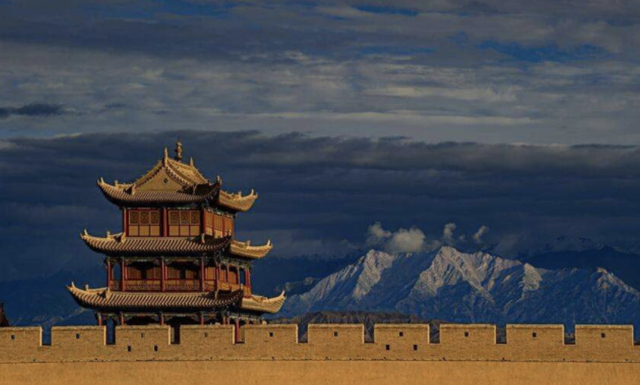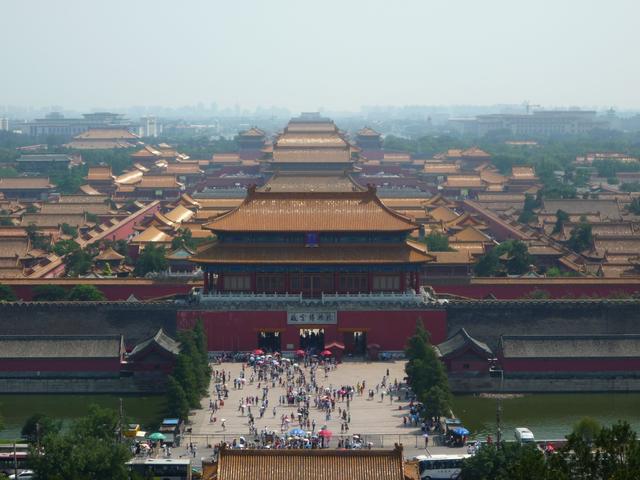美论坛:日本和欧洲都有城堡为何中国没有?网友:小国寡民才需要
由于古代中国和欧洲的社会结构不同。中世纪欧洲的城堡是所有拥有周围土地的大小贵族的防御基础设施。 贵族们有自己的军队来维持地方行政,并与其他贵族发生潜在的军事冲突。
自公元前221年以来,中国已成为一个中央集权的帝国。 封建制度从此被抛弃。 在中国古代,所有的土地、人民和权力都属于皇帝。 没有公爵或任何其他头衔的贵族。 城堡无法在这样的系统中存在,简而言之城堡是小国寡民的产物。在海外论坛上有这样一个讨论中西方城堡的热门话题:我听说过日本和欧洲的城堡,但中国人有类似的城堡吗?
让我们来看看国外的历史爱好者是怎么看待这个问题的吧。

话题:我听说过日本和欧洲的城堡,但中国人有类似的城堡吗?

网友Hayashi Miyako的观点
Chinese castles are very different from those of Europe or Japan.
中国的城堡与欧洲或日本的城堡非常不同。
Chinese castles were the cities themselves. Chinese people built walls around cities. Those are Chinese version of castles.
中国的城堡本身就是城市。中国人在城市周围筑起围墙。那是中国版的城堡。
the word that means “city” in Chinese is “城市”, that literally means “Castle/wall” and “market”. This clearly shows how the castles and the cities were integrated.
中文中“城市”的意思是“城市”,字面意思是“城堡/墙”和“市场”。这清楚地展示了城堡和城市是如何融合的。
from the beginning of the history of China, till the middle of 20th century, Chinese cities were physically surrounded by walls. people could only enter those cities from several gates.
从中国历史之初到20世纪中期,中国的城市都被城墙包围着。人们只能从几个门进入这些城市。
currently, due to the expansion of cities, those walls were mostly removed, but in some cities such as Xi’an, you can see remaining parts of those walls. Those are the Chinese castles.
现在,由于城市的扩张,这些城墙大多被拆除了,但在一些城市,如西安,你可以看到那些城墙的剩余部分。那些是中国古堡。

The difference of the castles came from differences of the wars.
城堡的不同源于战争的不同。
In medieval Japan or Europe, the wars are fought between feudal lords who intended to expand their territory, so the risks that ordinary people were killed were relatively low, because if lords killed people, the value of the land (tax income) became lower.
在中世纪的日本或欧洲,战争是封建领主之间为了扩张自己的领土而进行的,所以普通百姓被杀的风险相对较低,因为如果领主杀人,土地(税收)的价值就会降低。

On the other hand, the wars in China were much harsher, they fought with Northern nomads who typically did not intend to rule Chinese lands, but the purpose of the attacks were robbing wealth or people, or in the broad sense, removing farming culture from the land to make the land into the grass plain again.
另一方面,华夏的战争要残酷得多,他们与北方的游牧民族作战,这些游牧民族通常并不打算统治中国的土地,但攻击的目的是掠夺财富或人民,或者从广义上说,从土地上移除农耕文化,使土地重新变成草原。
Nomad people were unhappy that Chinese agriculture people expanded cultivated land and wanted to remove that totally. Therefore, the risk of people to be killed, robbed or sold as slaves for someone lived outside were quite high. The number of deaths per war were not comparable with other regions. Only way to protect people was surrounding walls.
游牧民族对华夏农业扩张耕地感到不满,想要完全消除耕地。因此,人们被杀害、抢劫或被卖为奴隶的风险是相当高的。每次战争的死亡人数无法与其他地区相比。唯一能保护人们的办法就是周围的墙。
This existence of wall has deeply affected Chinese society. Currently, Chinese people are registered as two type of people, rural people and urban people. This division actually has continued for several thousands of years. people who lived inside the walled cities were protected, educated and mainly involved in merchandising or politics. They are the people who drived Chinese history. People who lived outside of the walls were hardly protected, not educated and involved in farming. The society has been totally divided by the wall through out Chinese history.
城墙的存在深深影响了中国社会。目前,中国人登记为两类人,农村人和城市人。这种划分实际上已经持续了几千年。住在城墙之内的人受到保护,接受教育,主要参与商业或政治活动。他们是推动中国历史发展的人。住在城墙外的人几乎没有受到保护,没有受过教育,也从事农业。在中国历史上,这个社会一直被墙完全分割。

英籍华裔网友的观点
Chinese didn’t have castles similar to Japanese and European. In China, the emperor tended to construct palaces that cover a large area. But in Europe, people built high castles. So did the Japanese in part of their country.
中国人没有像日本人和欧洲人那样的城堡。在中国,皇帝倾向于建造占地面积很大的宫殿。但在欧洲,人们建造高城堡。日本人在他们国家的部分地区也是如此。
In my opinion, the difference comes from some facts. The most important reason is the different political system.
在我看来,这种差异来自于一些事实。最重要的原因是不同的政治制度。
Castles were first used to protect the land from attacks. In Europe, people began to build castles in medieval by the great Lords for preserving their lands and vast wealth. As the Carolingian dynasty broke, some lords owned lands and people so they had to make their “state” safe while conflicts may happen between lords at any moment. As a result, they built their houses with stones, added keeps, strengthened the walls, made them higher and higher(to get a bird’s-eye view), and finally, it became something we called “castles”.
城堡最初是用来保护土地免受攻击的。在欧洲,人们在中世纪开始建造城堡,由大领主保护他们的土地和巨大的财富。随着加洛林王朝的崩溃,一些领主拥有土地和人民,所以他们必须确保自己的“国家”的安全,而领主之间随时可能发生冲突。结果,他们用石头盖房子,加了堡垒,加固了城墙,把房子建得越来越高(以便鸟瞰),最后,它变成了我们称之为“城堡”的东西。

In Japan, during the shogunate, it was in the same situation as Europe. Shogun grasped enormous power and constructed their own protection individually.
日本幕府时期的情况与欧洲相同。幕府掌握了巨大的权力,并建立了自己的保护体系。
China is not a truly feudal society throughout history. China has ended its system of enfeoffment( the emperor conferred the land on vassals) since the Western Zhou Dynasty. There weren’t so many “lords” in the country, because the emperor mastered the land and power.
纵观历史,天朝并不是一个真正的封建社会。自西周以来,天朝就结束了分封(皇帝将土地授予诸侯)的制度。这个国家没有那么多“领主”,因为皇帝掌握土地和权力。
So nobilities could take charge of land and people, but they didn’t own them, all the things in the country belonged to the emperor. With less, weaker, and powerless nobility existing, it was no need for the emperor to make such a strong castle to protect its land from vassals. The lack of a strong enemy put the castles(protection inside the country) aside.
所以贵族可以管理土地和人民,但他们不拥有他们,国家的所有东西都属于皇帝。现在的贵族越来越少,越来越弱,越来越无力,皇帝没有必要建造如此坚固的城堡来保护自己的土地不受封臣的侵扰。由于缺乏强大的敌人,城堡(国内的保护)被搁置一边。

Secondly, the “war” appeared differently between European and Chinese. Europeans tried to conquer lands, defeat the other side by taking the cities, so it happened right down the cities and where they lived. But Chinese developed a way that soldiers took weapons and shields, stood in a square, and rushed to each other according to the tum.
其次,欧洲人和中国人之间的“战争”表现不同。欧洲人试图征服土地,通过占领城市来打败对方,所以事情就发生在城市和他们居住的地方。但中国人发展了一种方式,士兵拿着武器和盾牌,站成一个广场,按回合冲向对方。
Compared with Europeans, the Chinese tended to arrange the formal war far from the cities and obeyed rules. As you can see, castles are effective when guarded the lands, but it can’t apply to those early Chinese’s way of wars.
与欧洲人相比,中国人更倾向于在远离城市的地方安排正式战争,并遵守规则。正如你所看到的,城堡在守卫土地时是有效的,但它不适用于早期天朝的战争方式。
We can find clues from geography as well. The continent of Europe features in different landforms, it is easy to find highlands, mountains, or valleys. The castles greatly take the advantage of the landforms and make the investigation, defenses easier with the help of keeps, tower and magnificent height. In contrast, China features in plain, especially around the Yellow River basin.
我们也可以从地理上找到线索。欧洲大陆以不同的地形为特征,很容易找到高地、山脉或山谷。这些城堡极大地利用了地形优势,借助要塞、高塔和雄伟的高度,使考察、防御更加容易。相比之下,中国以平原为主,尤其是黄河流域。

Under this situation, the Chinese emphasized the width of the protection. We constructed the Great Wall to protect the land from external enemies. For continuous walls and several towers are more suitable for extensive land in China to fight against enemies. (the flat land makes the high castle useless in a war).
在这种情况下,中国人强调保护的宽度。我们修建长城是为了保护国土不受外敌的侵害。因为连续的城墙和多塔更适合在中国广阔的土地上与敌人作战。(地势平坦,高堡在战争中毫无用处)。

英国网友的观点
Well yeah but they were usually a lot bigger and less for royalty and more the general populace.
是的,但它们通常更大,很少为皇室服务,更多的是为普通民众服务。
It depends on how you define a castle. Noble fortress? So unfortunately, they were destroyed about 2,500 years ago. A centralised government does not allow local aristocrats to have too strong a family fortress.
这取决于你如何定义城堡。高贵的城堡?不幸的是,它们在2500年前就被摧毁了。中央集权的政府不允许地方贵族拥有过于强大的家族堡垒。
But if you're talking about walls, then, yes, China has a lot. They surrounded the whole city and had a complex system of doorways. Government officials were allowed to build walls to protect the city.
但如果你说的是城墙,那么,是的,中国有很多。他们包围了整个城市,有一个复杂的门道系统。政府官员被允许建造城墙来保护城市。

Every city has a city wall, Cheng Qian. The best preserved version is probably xian but you can see remnants in most cities older than a hundred or two hundred years. In Xian, which has a pretty small wall, it encompasses the inner city (most encompass whole city) and is 15m tall and 15m wide for the most part, and every 40m their is a watch tower with archers and stuff. Theirs a 50m most around it, and 4 huge gates.
每座城市都有城垣,城垣成千。保存最好的可能是西安,但你可以在大多数城市看到超过一两百年前的遗迹。在西安,它有一个非常小的城墙,它包围了内城(大部分包括整个城市),高15米,宽15米,每40米就有一个带弓箭手的瞭望塔。他们的距离大约50米,有4个巨大的大门。
So yeah those are common. I suppose the forbidden city is a castle in it's own right. Why do people need castles though? With such large populations and wealth they could just put everyone inside a huge castle. Japan and europe couldn't do that due to feudalistic isolated communities. They didnt have such huge cities such as chang an (except for constantinople. Which also lacked castles but had huge walls).

这些很常见。我想紫禁城本身就是一座城堡。为什么人们需要城堡呢?如此庞大的人口和财富,他们可以把每个人都关在一座巨大的城堡里。日本和欧洲由于封建孤立的社会而无法做到这一点。他们没有像长安这样的大城市(除了君士坦丁堡)。那里也没有城堡,但有巨大的城墙)。

中国网友的观点
One of the most comprehensive introduction of ancient Chinese defence buildings on Quora.
Quora上对中国古代防御建筑最全面的介绍之一。
The answer to this question can not be answered by a simple ‘yes’ or ‘no’.Like castles in Europe,there are many different kinds of ancient China’s defence buildings which have similar function as European castles. I will introduce each of them and give some examples, which will help you directly see that they are so different from European castles although they probably have similar functions.
这个问题的答案不能简单地用“是”或“不是”来回答。和欧洲的城堡一样,中国古代的防御建筑也有许多种类,其功能与欧洲的城堡相似。我将逐一介绍它们并给出一些例子,这将帮助你直接看到它们与欧洲城堡的不同之处,尽管它们可能有相似的功能。
1.边关要塞 Frontier Fortress

Frontier fortress is the most typical castle-like defence bulidings in ancient China. Usually, It consists of strong walls, huge archery buildings, at least one supportive town and a large number of beacon towers.
边关要塞是中国古代最典型的城堡式防御建筑。通常,它由坚固的城墙,巨大的射箭建筑,至少一个支持城镇和大量的烽火台组成。
Example 1: 嘉峪关 Jiayu Guan
Jiayu Guan is the west end of the Great Wall in Ming dynasty. It’s one of the most important fortress than defend invasion from nomadic invaders, like Mongols.
嘉峪关是明代长城的西端。它是抵御蒙古等游牧民族入侵最重要的堡垒之一
Image above: You can see a beacon tower on the top of that mountain.

上图:你可以看到山顶上有一座烽火台。
Image above: The former supportive town is now a part of an industrial city, Jiayuguan city.
上图:以前的给予帮助的小镇现在是工业城市嘉峪关市的一部分。
As for Jiayu Guan, it can't be ignored that she is connected with the Great Wall. Jiayu Guan and the Great Wall nearby strengthened defensive capability of each other and become a systematic defence together.
至于嘉峪关,她与长城的联系是不可忽视的。嘉峪关与附近的长城相互加强了防御能力,共同形成了系统的防御
2. 城市防御建筑City Defense Building
Usually, ancient city in China doesn’t have european style castle as crucial defense. The most important facility is its wall, which is not a single wall but consists of different defensive facilities like anarchy towers,瓮城weng cheng, city moat and other defense facilities.
中国的古代城市通常不会有欧式城堡作为关键防御。最重要的设施是它的城墙,这不是一个单一的墙,而是由不同的防御设施,如无政府塔,瓮城瓮城,护城河和其他防御设施。
Example: Xi’an City Wall

例如:西安城墙
Firstly built in 582 AD and expanded in 1369 AD, Xi’an City Wall s the best preserved ancient city wall in China.
西安城墙始建于公元582年,公元1369年扩建,是中国保存最完好的古城墙
Nowadays, Xi'an City Wall is no longer a defense facility but one of the most important part in Xi'an. Residents of Xi'an can celebrate festival and hold weddings here.
如今,西安城墙不再是防御设施,而是西安最重要的部分之一。西安的居民可以在这里庆祝节日,举行婚礼。
Non-stateowned Defense Buildings
非国有的防御建筑
Private defense buildings are actually more close to the definition of ‘castle’.
私人防御建筑其实更接近于“城堡”的定义:
Scholars debate the scope of the word castle, but usually consider it to be the private fortified residence of a lord or noble.
学者们对“城堡”一词的范围争论不休,但通常认为它是领主或贵族的私人加固住宅。
Although in ancient China there were few highly independent feudal lords like those in the middle ages of Europe after 221BC, when Emperor Qin Shihuang exterminated seperated kings and lords and united China under the rule of one absolute emperor, some rich small nobles, especially in remote and dangerous region like Caton and Fujian, still built their own private fortified residence for their own family. And during the period of civil wars, rich nobles and businessmen did same thing in the central parts of China.
虽然中国古代很少有像欧洲中世纪的秦始皇公元前221年以后那样高度独立的封建主,但一些富有的小贵族,尤其是在卡顿、福建等偏远而危险的地区,仍然为自己的家庭建造了自己的私人堡垒住宅。在内战时期,富裕的贵族和商人也在中国的中部地区做同样的事情。
(1)Fujian Tulou/earth buildings

福建土楼建筑
The most famous of this kind of defense building isFujian Tulou/earth buildings.
这种防御建筑中最著名的是福建土楼。
A Tulou is usually a large, enclosed and fortified earth building, most commonly rectangular or circular in configuration, with very thick load-bearing rammed earth walls between three and five stories high and housing up to 800 people. Smaller interior buildings are often enclosed by these huge peripheral walls which can contain halls, storehouses, wells and living areas, the whole structure resembling a small fortified city.
土楼通常是大型的、封闭的、加固的土楼,最常见的形状是矩形或圆形,有非常厚的承重夯土墙,三到五层楼高,可容纳800人。较小的内部建筑通常被这些巨大的外围墙包围,包括大厅、仓库、水井和生活区,整个结构就像一个小的防御城市。
Image above: If observed from the sky, a series of Tulou can be a group of protective and systematic defense facilities. Attack any one of them will get resistance from all.
上图:如果从空中观察,一系列的土楼可以是一组保护和系统的防御设施。攻击他们中的任何一个都会得到所有人的抵抗。
Nowadays, Tulou is no longer a defense building. But it already became a symbol of Hakka and closely connected with Hakka culture.
如今,土楼不再是防御建筑。但它已成为客家的象征,与客家文化紧密相连。
(2)Southwestern minorities' fortresses
西南少数民族碉堡
Minorities in Southwest China use castle-similar fortress since 3rd century BC at least.

中国西南的少数民族至少从公元前3世纪开始使用类似城堡的堡垒。
Qiang, one of the most ancient ethnic groups in China, used an unique fort to protect their villages. In a sense, it’s a more wretched and smaller version of a castle. Don’t forget many of the Qiang forts that we can see today were built 2000 years ago.
羌族是中国最古老的民族之一,他们使用独特的堡垒来保护他们的村庄。 从某种意义上说,它是一座更可怜、更小版本的城堡。 不要忘记我们今天看到的许多羌寨是在 2000 年前建造的。
The most castle-like buildings in China were built by Tibetans. Castles in Tibet usually have military, political and religious functions.
中国最像城堡的建筑是由藏族建造的。西藏的城堡通常具有J事、Z治和Z教功能。
In 634 AD, Like Shiming, emperor of Great Tang Empire, married his daughter, Princess Wen Cheng Gong Zhu (mun Chang kung co in Tibetan language), to Songzain Gambo, king of Tibet. When Princess Wen Cheng went to Tibet, she took China's best craftspersons to Tibet, spreading many China's advanced technology to Tibet, including building technology.
公元634年,大唐帝国的皇帝如世明将自己的女儿文成恭朱公主嫁给了西藏国王松赞干布。当文成公主去西藏时,她把唐朝最优秀的工匠带到西藏,把唐朝许多先进的技术传播到西藏,包括建筑技术。
One consequence of this great marriage is the Potala Palace. Songzain Gambo used his wife's craftsperson to build a new castle which combined two different styles from both Tibet and mainland China.

这一伟大联姻的结果之一就是布达拉宫。松赞干布让他妻子的工匠建造了一座新的城堡,融合了西藏和中原两种不同的风格。

新加坡网友的观点
If I’m correct (which I am most of the time), the Chinese used to have European-like castles during the Spring and Autumn period, roughly 2700 years ago plus or minus. A lot of these “castles” grew into city-states-like feudal entities that became de facto independent as the Zhou royal authority got weakened. After the Qin dynasty unified China, these city-states have transitioned into regular, walled cities with the disappearance of castle-like structures in the centre.
如果我是对的(大多数时候我是对的),在春秋时期,大约2700年前左右,中国人曾经有过类似欧洲的城堡。很多这样的“城堡”发展成为城邦——类似于封建实体,随着周朝王权的削弱,这些封建实体实际上变得独立。秦朝统一中国后,这些城邦国家已经转变为正规的、有城墙的城市,中心的城堡式建筑消失了。
Nations that cultivated a tradition of castle building usually have stayed under feudalism for a long period of time, which is also why Japan has more of these “European-like” castles than China, which phased them out long ago as power became centralized.
有建城传统的国家通常长期处于封建主义状态,这也是为什么日本拥有比中国更多的这些“欧洲式”城堡的原因,中国很早就随着权力集中而逐步淘汰它们。

日本城堡
Just imagine if every nobleman in China was allowed to build his own castle. The emperor’s power would weaken so much that he becomes nothing more than a figurehead like the Japanese emperor before Meiji Restoration. Therefore, for most of its history, Chinese cities were largely fortified settlements that relied on public defences like city walls. The towers and city gates of these settlements do kinda look like a European castle (if you’re standing at the right angle), but they’re fundamentally different structures.
想象一下,如果中国的每个贵族都被允许建造自己的城堡。天皇的权力会被削弱,就像明治维新之前的日本天皇一样,只是一个有名无实的领袖。因此,在历史上的大部分时间里,中国的城市主要是依靠城墙等公共防御设施的坚固定居点。这些居民点的塔楼和城门看起来确实有点像欧洲城堡(如果你站在正确的角度),但它们的结构根本不同。
Basically, a European castle is like a single-family detached home. Chinese and European defensive walls, on the other hand, are like the fences around your standalone house.
基本上,欧洲城堡就像一个独栋的独立住宅。另一方面,中国和欧洲的防御墙就像你独立房子周围的栅栏。

Then again, there’s always a few exceptions in history (!). When the latest European fortification tech was transferred to the Ming dynasty, the Chinese did install a few of these forts against the Manchus (although forts are still not castles, they are much closer). But too few of them were built, and far too late.
当然,历史上也有一些例外(!)当欧洲最新的防御技术被转移到明朝时,中国人确实安装了一些这样的堡垒来对抗满族人(尽管堡垒仍然不是城堡,它们更接近于城堡)。但建造的太少了,而且太晚了。




















评论